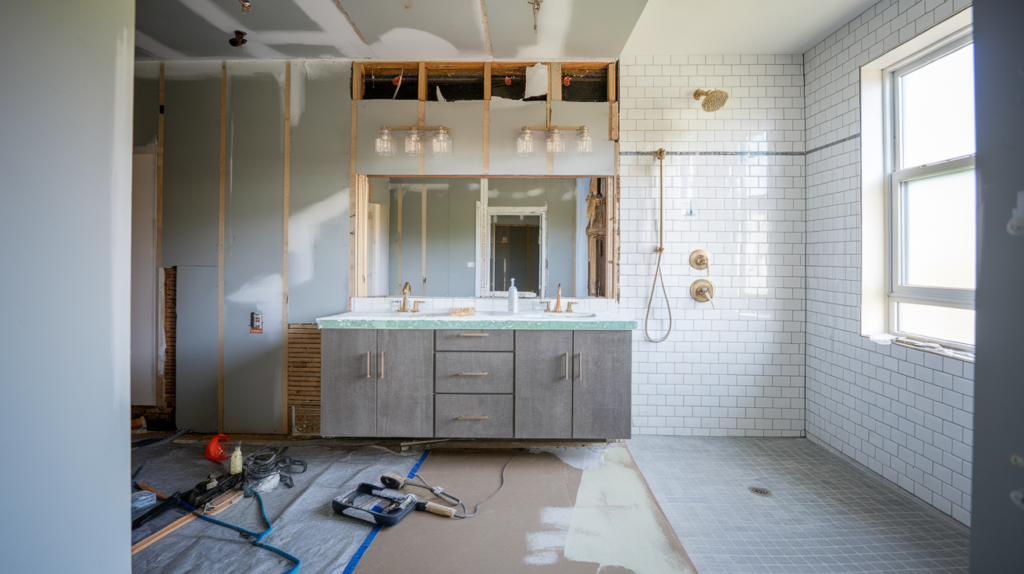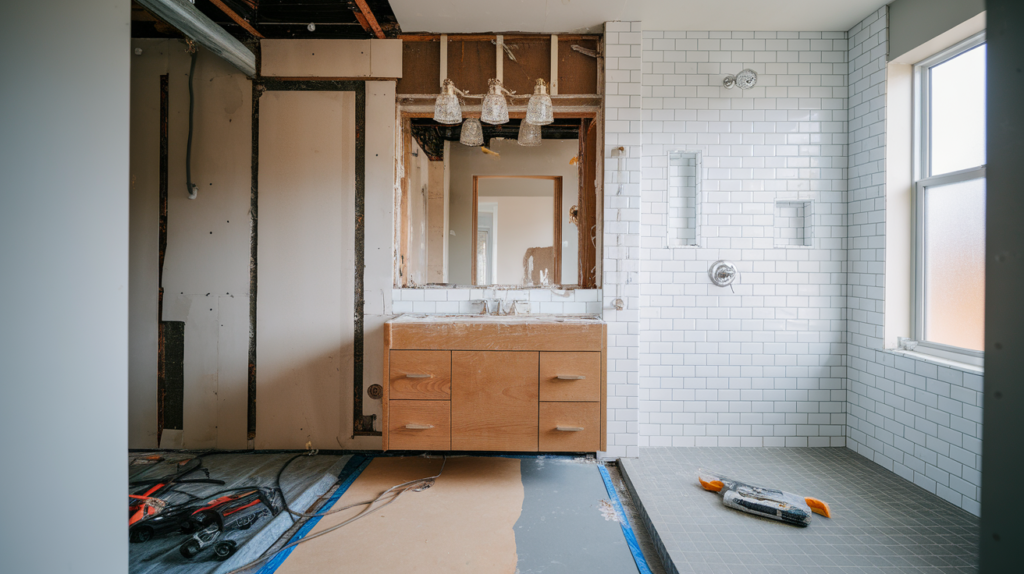Planning a bathroom remodel? You’re not alone; it’s one of the most popular ways to enhance the value and comfort of your home.
But here’s what many people don’t mention: timing is more important than you think. Without good planning, a two-week job can drag into two months.
I’ve seen many homeowners get frustrated simply because no one set clear expectations. You deserve honest answers, and that’s what this guide offers.
You’ll learn how long remodels usually take, what causes delays, and how to stay on track.
These tips are based on real experience, not just theory.
By the end, you’ll know what to expect and how to plan your project effectively.
Importance of Understanding Timelines for Bathroom Remodel
Time is money, and that saying fits when you’re remodeling a bathroom.
When you understand how long things take, you can make smarter choices and avoid last-minute stress.
Planning helps you prepare better. You can set up a backup bathroom, take time off work for inspections, and help your family adjust their daily routines.
Many people believe bathroom remodels only take a few days. However, that’s not true, and thinking that way can lead to stress and poor decisions.
Delays usually mean higher costs. Contractors may charge more, and you may need to stay in a place longer than expected.
Rushing can lead to mistakes, and fixing those mistakes can be even more costly. Knowing the timeline helps everything go smoother.
Bathroom Remodel Timeline

Most bathroom remodels fall within a 2–4 week range, especially when you’re doing a complete renovation with standard fixtures and no significant layout changes.
Knowing what happens each week helps you stay informed, plan, and manage expectations with your contractor.
| Week | Work Done |
|---|---|
| Week 1 | Demolition and prep work begin. Old fixtures, tiles, and drywall are removed. Plumbers and electricians upgrade systems inside walls. |
| Week 2 | New plumbing and electrical work is completed. Drywall is installed and painted. Flooring may also be started. |
| Week 3 | Tile is laid, and new vanities, lighting, and fixtures are installed. Your new bathroom starts to look complete. |
| Week 4 | Final plumbing, hardware, and trim go in. The contractor does a walkthrough and final cleanup. |
If you’re doing a quick update, such as changing fixtures or repainting, it may take only 3–5 days. But if you’re moving walls or adding plumbing, expect a longer timeline of 6–8 weeks.
Factors Influencing the Bathroom Remodel Duration

Several key factors determine the actual duration of your bathroom remodel. Each project is unique. Understanding these factors helps you plan more accurately.
1. Bathroom Size and Layout
Smaller bathrooms are quicker to remodel. A powder room may take just a week, while an oversized master bath needs more time.
Changing layouts slows everything down. Moving pipes or wires requires extra permits and inspections.
If you’re keeping fixtures in the same spot, work goes much faster.
Adding features like grab bars or walk-in showers takes extra time and care. The bigger or more complex your bathroom is, the longer the project will take.
2. Scope of Work
The amount of work you do affects your timeline. Minor updates, such as new paint or fixtures, may only take a few days.
Full remodels can take weeks, especially when starting from scratch.
Significant changes, such as relocating walls or raising ceilings, require expert assistance. That adds time.
Custom tile or built-in storage also requires more time to install. The more detailed your project is, the more time it will require.
3. Permits and Inspection
Most remodels need permits for plumbing and electrical work. These usually take 1–2 weeks to get.
Inspections must happen at specific points. You can’t move forward until each one passes.
Delays occur when inspectors are busy or work needs to be addressed.
Skipping permits may seem faster, but they create bigger issues later, mainly if you sell your home. Following the rules keeps your project legal and safer in the long run.
4. Material Availability
If you choose basic or stock materials, they usually arrive fast. Items like standard faucets and lights can show up in just a few days.
But custom items like special tiles or made-to-order vanities take weeks. Sometimes popular materials are out of stock, especially during busy seasons.
Shipping delays also happen. Bad weather or holidays slow things down. To avoid waiting, order materials in advance and allow yourself extra time.
Always have backup choices, just in case something is delayed. Planning keeps your project moving and avoids stress when things don’t arrive on time.
5. DIY vs Hiring Contractors
Contractors work faster and more efficiently.
They have tools, skills, and suppliers ready to go.DIY projects take longer, especially if you’re learning as you go.
Weekend work adds up slowly, and mistakes can lead to significant delays.
Mixing your work with a pro’s can lead to scheduling problems. If you want it done more quickly and efficiently, hiring help is often worth it.
6. Unforeseen Issues
Older homes often hide big surprises. You may find old pipes, bad wires, or mold behind the walls. Resolving these issues requires additional time and resources.
Water damage is another common problem. Leaks or wet spots must be repaired before any further action can be taken. This can delay your project for days or even weeks.
Also, older bathrooms may not meet today’s safety codes. If something doesn’t follow the rules, you’ll need to fix it.
All these hidden issues slow things down, so always plan for the unexpected when remodeling an older space.
Tips for Staying on Schedule
The following is how you can get everything done on time:
- Start with Realistic Expectations: Plan for potential delays and surprises. Add a 20% time buffer to your initial timeline to stay prepared and reduce stress.
- Order All Materials Before Demolition Begins: Ensure all fixtures, tiles, and supplies are delivered and checked before tearing anything down. This helps prevent unnecessary delays.
- Communicate Weekly with Your Contractor: Set up regular check-ins to stay updated on progress and address any issues early before they snowball into bigger problems.
- Have Backup Plans for Bathroom Use: If it’s your only bathroom, plan for alternatives in case the project runs longer than expected, like using a neighbor’s or gym facility.
- Avoid Making Changes Once the Project Has Started: Changing your mind mid-renovation can slow things down and increase costs. Finalize all decisions before work begins.
- Schedule Inspections as Soon as Each Phase Is Ready: Don’t wait to book inspections – scheduling them promptly keeps the project moving and avoids long gaps between phases.
Conclusion
Most bathroom remodels take approximately 2 to 4 weeks when planned and managed effectively.
This timeline works for complete renovations with basic layouts and standard fixtures.
Planning makes a big difference. When you understand what affects timing, such as size, permits, materials, and unexpected issues, you can set more realistic expectations.
Even the best plans sometimes face delays. Factors such as adverse weather conditions or shipping issues can slow down the project. Being flexible helps reduce stress when that happens.
Rushing the job can lead to mistakes that are more expensive to correct later. It’s better to take your time and do things the right way.
Your remodel is an investment in comfort and value. With good planning and patience, the results will be worth it. What’s your timeline? Share your thoughts and tips in the comments!
Frequently Asked Questions
Can I Use My Bathroom During a Remodel?
Usually not. During major remodeling, water may be shut off and fixtures removed. Plan to use another bathroom or make temporary arrangements during the project.
What Takes the Longest in a Bathroom Remodel?
Tile work, custom features, and waiting for permits or materials usually take the longest. Detailed designs and high-end finishes also add time to the overall project.
How Long Does Bathroom Tile Installation Take?
Tile installation takes 2–4 days, depending on the size and layout. Drying time between steps, such as adhesive and grout, also affects the pace of work.
How Long Does Plumbing Work Take in a Bathroom Remodel?
Plumbing updates take 1–2 days for basic layouts. If you’re moving fixtures or replacing old pipes, it can take several more days, depending on the complexity.

